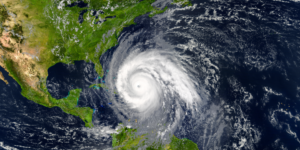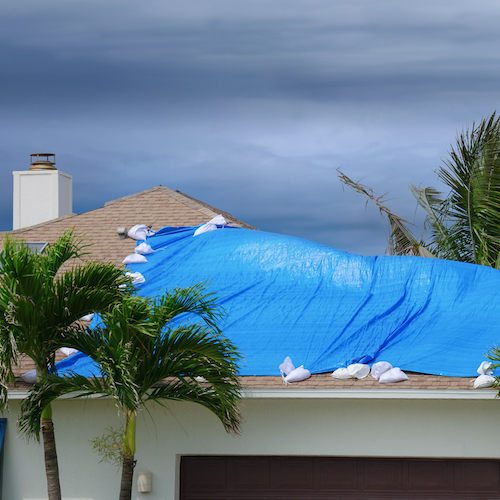
As of July 6, 2021, Tropical Storm Elsa is on track to make its way through the southern and eastern United States through the week — bringing with it heavy rain, strong winds, storm surge, and tornadoes as it threatens to turn into a hurricane.
With hurricane season lasting from June 1, 2021, to November 30, 2021, the National Oceanic and Atmospheric Administration (NOAA) is predicting an above-average period for storms, noting that it expects 13–20 named storms and 6–10 named hurricanes during the year.
The country is still recovering from the damages of 2020, as well. NOAA notes that 22 natural weather and climate disasters — including 13 severe storms and seven tropical cyclones — caused damages of $95 billion alongside the deaths of 262 people.
In the aftermath of any major weather event, major construction tends to follow, as repair and construction work become high priorities in recovering from disasters. As the COVID-19 pandemic continues to greatly affect the United States — with public safety issues, rising prices, and supply shortages affecting construction — hurricane season in 2021 brings with it new levels of concern.
Contractors can expect to face weather-related delays, increased storm repair workload, and possibly worsened material shortages as hurricane season continues to impact the US.
Read more: Disaster Recovery and Construction Go Hand in Hand
Storms bring delays, damage, and reduced productivity
Each year, storms bring extensive damage to property and people which requires new construction and repairs, but an often-overlooked aspect is the effect of weather disasters on current construction.
Levelset’s Alex Bennaroche notes that force majeure events, like hurricanes, can cause major issues for contractors if clauses aren’t included in contracts.
“A force majeure clause relieves one party from performing a contractual obligation under certain circumstances that would make performance impractical, impossible, or even illegal…when superior external forces such as a storm or a natural disaster affect a project participant’s ability to successfully complete their responsibilities in full or in a timely manner on a construction project.”
“Imagine work has begun on a project in Florida,” Bennaroche continues. “Two weeks into the build, a category 5 hurricane makes landfall in your area. Without a force majeure clause in the construction contract, a contractor could potentially be sued for not completing his work on time.”
With these types of clauses, there’s often a high potential for disputes to arise concerning delays, damages, and any subsequent project extensions, making this a particularly important part of any contract in an area often affected by major storms.
Major disasters often result in increased supply shortages, as well — an issue which becomes even more pronounced when considering the major materials shortages currently faced worldwide. Previous major storms have seen supply shortages directly tied to the closure of affected plants.
“We [experienced] rationing of PVC-related products by manufacturers because of the natural gas component in producing that product,” said Ferguson Plumbing Spokesperson Christine Dwyer regarding the impact of Hurricane Harvey in Texas during 2017. “With many of the natural gas facilities affected in Texas and the subsequent rebuilding efforts, PVC pipe and fittings are always one of the hardest commodities to get after a major storm.”
John Fitzgerald, executive vice president for operations for major HVAC company Rheem, noted that previous hurricanes actually affected the company most in terms of labor.
“For the most part, work-in-progress inventory, especially that of the larger builders, came through largely intact with some damage and theft,” Fitzgerald said about Hurricane Harvey. “But, according to reports from numerous builders, the vast majority of disruption was manpower and traffic-related, and not a result of significant physical damage.”
A number of officials in heavily affected states are taking steps to enforce construction delays during storm seasons, as well — a recent Westlake, Florida notice reminded contractors that “Upon the issuance of a tropical storm or hurricane warning for our area by the National Weather Service, all normal construction activities are ordered to cease except for those activities directly necessary to secure a project or site in preparation for a storm event.”
It’s also important for contractors to consider that the ongoing pandemic only adds to the issues that large storms cause. Contractors who are well-prepared for the outcomes of both have seen more success in recent years.
“By the time the pandemic hit, both the process and work…was well-established,” said Michael Boylan, chairman of the Northeast Florida Long-Term Recovery Organization, “a collaborative network of about 30 governmental, business, faith-based, and nonprofit organizations” formed following Hurricane Irma to assist construction efforts.
“The pandemic only increased the urgency of our work, knowing full well that these families were ‘quarantined’ in homes that were neither safe nor secure.”

Have a question?Levelset can help.
Recovering from a major storm can bring lots of construction payment questions for even the most seasoned professionals.
Read previous questions — and get your questions answered by a community of credit managers, lawyers, and construction professionals, all for free.
Storms cause repair work, new construction — spurring more shortages and higher prices
Contractors specializing in repair will undoubtedly have a rise in work following any hurricane season, as the repair of extensive damage is one of the main components of any disaster recovery effort.
A September 2018 report by Moody’s Analytics estimated that 2018’s Hurricane Florence had caused between $38–$50 billion of damage in the United States, with most of that damage dealt to property.
A 2017 report from the same source noted that damages and lost productivity stemming from Hurricanes Harvey and Irma would result in $150-200 billion in costs.
Repairs require significant labor, as well. According to a report from Fox Business, it was estimated that, in the aftermath of 2017’s Hurricane Harvey, Houston, Texas would need an additional 10,000–20,000 construction workers to rebuild what was approximately 30,000 damaged and destroyed houses.
While high demand has also driven up prices in the past, reports have claimed that labor and materials shortages are often localized and don’t result in major nationwide increases.
Of course, these local examples of inflation can often be significant: For example, post-Hurricane Harvey prices of lumber, drywall, and fiberboard jumped by 20% in Texas when compared to pre-hurricane levels.
However, the rise in new construction may not last a significant amount of time following any storms. Speaking of the possible effects of major storms like Hurricanes Harvey and Irma in 2017, John Fitzgerald noted that bumps in activity may not last more than half a year.
“I do feel there will be a sizable trailing bump to regional residential new construction activity in south Texas and throughout Florida because so many existing homes were significantly damaged,” Fitzgerald said of the possibilities for a year following major storms. “I think this will positively affect Q1 and part of Q2, but will more than likely wash out by end of Q2.”
Issues with government assistance add more concern for both homeowners and contractors
Though organizations such as the Federal Emergency Management Administration (FEMA) exist to help people navigate disasters such as hurricanes, it’s often difficult for that money to go straight to individual homeowners for the funding of repairs — especially when repairs are extensive and costs are driven up by materials issues.
Christine Dwyer noted that, in 2017, FEMA approved over $23.5 million in individual assistance for those impacted by Hurricane Harvey, with estimated $163 million for those impacted by Hurricane Irma — however, the maximum FEMA approved per grant at the time was $33,300, a number that is often insufficient for significant repairs.
For example, September 11, 2017, saw historic flooding in Jacksonville, Florida caused by Hurricane Irma, resulting in thousands of homes damaged — and sometimes left completely uninhabitable.
In many cases, even individual projects can seem small and relatively inexpensive, storms put significant pressure on these individual homeowners. An example from Hurricane Irma is Kushanna Danglade’s Moncrief Park, Florida home which sustained roof and floor damage in the 2017 storm; despite relatively minor damage, the repairs were not completed until May 2021 — coming at a cost of $12,075.
In the years following Irma, the Northeast Florida Long-Term Recovery Organization — “a collaborative network of about 30 governmental, business, faith-based, and nonprofit organizations” — matched available home-repair funds with property owners, spurring major construction in North and Central Florida.
Though a number of jobs remain to be completed, since 2017 the organization has helped repair around 4,200 homes in Florida’s Duval and Nassau counties — an endeavor coming at a total cost of $3.4 million.
Even with government funding available, construction funding following large storms can often come from conglomerate and collaborative sources. Financing can take years — Michael Boylan noted that his organization was told that “it was not at all uncommon for such efforts to take this long.”
“What surprised me the most was, even with hundreds of millions of federal dollars…how important it was for local non-governmental donors to fund home repairs for low-income homeowners who would not otherwise recover from Irma,” said Northeast Florida Long-Term Recovery Organization Vice Chairman John Sapora. “Disaster recovery is mainly local people looking out for one another after a storm.”
Larger governmental funds don’t always provide significant help to affected residents, as well. Jacksonville, Florida’s Harold Wolfgang Langer contacted FEMA following Irma as he had extensive damage, with water in his home’s living room and a badly damaged roof that needed to be replaced. However, FEMA offered him only $350 to finance the repairs needed.
“It was that bad,” Langer noted. “That was all they were going to do.”
The financial effects of the storm made it such that, like many residents following a large storm, Langer couldn’t afford repairs without outside assistance. “I had to wait. I didn’t have much choice,” he said.
“Seeing firsthand, and many times over, the devastation to homes and property…I came to appreciate the sense of urgency all of us should feel when it comes to developing a comprehensive resiliency plan for our community,” Michael Boylan added.
Is your construction business ready for hurricane season?
Read the guide by experienced Louisana construction attorney Matt Viator now.